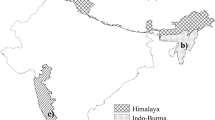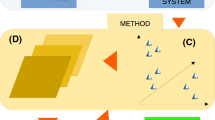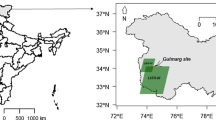Abstract
Polar biodiversity should be monitored as an indicator of climate change. Biodiversity is mainly observed by field survey although this is very limited in broad inaccessible polar regions. Satellite imagery may provide valuable data with less bias, although spatial, spectral, and temporal resolutions are limited for analyzing biodiversity. The present study has two objectives. The first is constructing a first-ever vegetation map of the entire Barton Peninsula, Antarctica. The second is developing a monitoring method for long-term variation of vegetation, based on satellite images. Dominant mosses and lichens are distributed in small and sparse patches, which are limited to analysis using high-resolution satellite images. A sub-pixel classification method, spectral mixture analysis, is applied to overcome limited spatial resolution. As a result, vegetation shows high abundance along the southeastern shore and low-to-medium abundance in the nearly snow-free inland area. Even though spatial patterns of vegetation were almost invariant over 6 years, there was interannual variation in abundance aspects because of meteorological conditions. Therefore, extensive and long-term monitoring is needed for aspects of distribution and abundance. The present results can be used to design field surveys and monitor long-term variation as elementary data.









Similar content being viewed by others
References
Barcikowski A, Gurtowska J (1999) Studies on the biomass of selected species of Antarctic mosses on King George Island, South Shetland Islands, Antarctica. Pol Polar Res 20:283–290
Bergstrom DM, Turner PAM, Scott J, Copson G, Shaw J (2006) Restricted plant species on sub-Antarctic Macquarie and Heard Islands. Polar Biol 29:532–539. doi:10.1007/s00300-005-0085-2
Bhatt US, Walker DA, Raynolds MK, Comiso JC, Epstein HE, Jia G, Gens R, Pinzon JE, Tucker CJ, Tweedie CE, Webber PJ (2010) Circumpolar arctic tundra vegetation change is linked to sea ice decline. Earth Interact 14:1–20. doi:10.1175/2010EI315.1
Bokhorst S, Huiskes A, Convey P, Aerts R (2007) External nutrient inputs into terrestrial ecosystems of the Falkland Islands and the Maritime Antarctic region. Polar Biol 30:1315–1321. doi:10.1007/s00300-007-0292-0
Chen CM, Hepner GF, Forster RR (2003) Fusion of hyperspectral and radar data using the HIS transformation to enhance urban surface features. ISPRS J Photogramm Remote Sens 58:19–30. doi:10.1016/S0924-2716(03)00014-5
Chung H, Lee BY, Chang SK, Kim JH, Kim Y (2004) Ice cliff retreat and sea-ice formation observed around King Sejong Station in King George Island, West Antarctica. Ocean Polar Res 26:1–10
Convey P (2011) Antarctic terrestrial biodiversity in a changing world. Polar Biol 34:1629–1641. doi:10.1007/s00300-011-10068-0
Fretwell PT, Convey P, Fleming AH, Peat HJ, Hughes KA (2011) Detecting and mapping vegetation distribution on the Antarctic Peninsula from remote sensing data. Polar Biol 34:273–281. doi:10.1007/s00300-010-0880-2
Frohn RC, Hinkel KM, Eisner WR (2005) Satellite remote sensing classification of thaw lakes and drained thaw lake basins on the North Slope of Alaska. Remote Sens Environ 97:116–126. doi:10.1016/j.rse.2005.04.022
Furmanczyk K, Ochyra R (1982) Plant communities of the Admiralty Bay region (King George Island, South Shetland Islands, Antarctic). Pol Polar Res 3:25–39
Green AA, Berman M, Switzer P, Craig MD (1988) A transformation for ordering multispectral data in terms of image quality with implications for noise removal. IEEE Trans Geoscience Remote Sens 26:65–74
Green ATG, Sancho LG, Pintado A, Schroeter B (2011) Functional and spatial pressures on terrestrial vegetation in Antarctica forced by global warming. Polar Biol 34:1643–1656. doi:10.1007/s0030-011-1058-2
Jensen JR (2005) Introductory digital image processing: a remote sensing perspective, 3rd edn. Pearson Prentice Hall, New Jersey, pp 431–465
Kennedy AD (1993) Photosynthetic response of the Antarctic moss Polytrichym alpestre Hoppe to low temperatures and freeze-thaw stress. Polar Biol 13:271–279
Kim JH, Ahn IY, Hong SG, Andreev M, Lim KM, Oh MJ, Koh YJ, Hur JS (2006) Lichen flora around the Korean Antarctic scientific station, King George Island, Antarctic. J Microbiol 44:480–491
Kim JH, Ahn IY, Lee KS, Chung H, Choi HG (2007) Vegetation of Barton Peninsula in the neighbourhood of King Sejong station (King George Island, maritime Antarctic). Polar Biol 30:903–916. doi:10.1007/s00300-006-0250-2
Kim H, Kim T, Lee H (2012) Brightness value comparison between KOMPSAT-2 images with IKONOS/GEOEYE-1 images. Korean J Remote Sens 28:181–189
Laidler GJ, Treitz PM, Atkinson DM (2008) Remote sensing of arctic vegetation: relations between the NDVI, spatial resolution and vegetation cover on Boothia Peninsula, Nunavut. Arct 61:1–13
Lee BY, Won Y, Oh SN (1997) Meteorological characteristics at King Sejong Station, Antarctica (1988–1996). Report BSPE 97604-00-1020-7. Korea Ocean and Developmental Institute, pp 571–599
Lee JS, Lee HK, Hur J, Andreev M, Hong SG (2008) Diversity of the lichenized fungi in King George Island, Antarctica, revealed by phylogenetic analysis of partial large subunit rDNA sequences. J Microbiol Biotechnol 18:1016–1023
Murray H, Lucieer A, Williams R (2010) Texture-based classification of sub-Antarctic vegetation communities on Heard Island. Int J Appl Earth Obs Geoinfo 12:138–149. doi:10.1016/j.jag.2010.01.006
Okin GS, Roberts DA, Murray B, Okin W (2001) Practical limits on hyperspectral vegetation discrimination in arid and semiarid environments. Remote Sens Environ 77:212–225
Pannewitz S, Schlensog M, Green TGA, Sancho LG, Schroeter B (2003) Are lichens active under snow in continental Antarctica? Ecophysiol 135:30–38. doi:10.1007/s00442-002-1162-7
Pereira AB, Spielmann AA, Martins MFN, Francelino MR (2007) Plant communities from ice-free areas of Keller Peninsula, King George Island, Antarctica. Oecol Bras 11:14–22
Poole I, Hunt RJ, Cantrill DJ (2001) A fossil wood flora from King George Island: ecological implications for an Antarctic Eocene vegetation. Ann Bot 88:33–54. doi:10.1006/anbo.2001.1425
Raynolds MK, Walker DA, Maier HA (2006) NDVI patterns and phytomass distribution in the circumpolar Arctic. Remote Sens Environ 102:217–281. doi:10.1016/j.rse.2006.02.016
Raynolds MK, Comiso JC, Walker DA, Verbyla D (2008) Relationship between satellite-derived land surface temperatures, artic vegetation types, and NDVI. Remote Sens Environ 112:1884–1894. doi:10.1016/j.rse.2007.09.008
Robin M, Chapuis JL, Lebouvier M (2011) Remote sensing of vegetation cover change in islands of the Kerguelen archipelago. Polar Biol 34:1689–1700. doi:10.1007/s00300-011-1069-z
Robinson SA, Wasley J, Tobin AK (2003) Living on the edge-plants and global change in continental and maritime Antarctica. Glob Chang Biol 9:1681–1717
Sancho LG, Pintado A (2004) Evidence of high annual growth rate for lichens in the maritime Antarctic. Polar Biol 27:312–319. doi:10.1007/s00300-004-0594-4
Selkirk PM, Skotnicki ML (2007) Measurement of moss growth in continental Antarctica. Polar Biol 30:407–413. doi:10.1007/s00300-006-0197-3
Stow DA, Hope A, McGuire D, David V, Gamon J, Huemmrich F, Houston S, Racine C, Sturm M, Tape K, Hinzman L, Yoshikawa K, Tweedie C, Noyle B, Silapaswan C, Douglas D, Griffith B, Jia G, Epstein H, Walker D, Daeschner S, Petersen A, Zhou L, Myneni R (2004) Remote sensing of vegetation and land-cover change in Arctic Tundra Ecosystems. Remote Sens Environ 89:281–308. doi:10.1016/j.rse.2003.10.018
Théau J, Peddle DR, Duguay CR (2005) Mapping lichen in a habitat of Northern Quebec, Canada, using an enhancement-classification method and spectral mixture analysis. Remote Sens Environ 94:232–243. doi:10.1016/j.rse.2004.10.008
Torres-Mellado GA, Jaña R, Cassanova-Katny MA (2011) Antarctic hairgrass expansion in the South Shetland archipelago and Antarctic Peninsula revisited. Polar Biol 34:1679–1688. doi:10.1007/s00300-011-1099-6
Victoria FC, Pereira AB, Da Costa DP (2009) Composition and distribution of moss formations in the ice-free areas adjoining the Arctowski region, Admiralty Bay, King George Island, Antarctica. Iheringia Sér Bot 64:81–91
Xie Y, Sha Z, Yu M (2008) Remote sensing imagery in vegetation mapping: a review. J Plant Ecol 1:9–23. doi:10.1093/jpe/rtm005
Acknowledgments
This study was supported by Korea Polar Research Institute (PE14040 and PE14020) and Korea Aerospace Research Institute (PG14010). Thanks to the anonymous reviewers with helpful comments.
Author information
Authors and Affiliations
Corresponding author
Rights and permissions
About this article
Cite this article
Shin, JI., Kim, HC., Kim, SI. et al. Vegetation abundance on the Barton Peninsula, Antarctica: estimation from high-resolution satellite images. Polar Biol 37, 1579–1588 (2014). https://doi.org/10.1007/s00300-014-1543-5
Received:
Revised:
Accepted:
Published:
Issue Date:
DOI: https://doi.org/10.1007/s00300-014-1543-5




